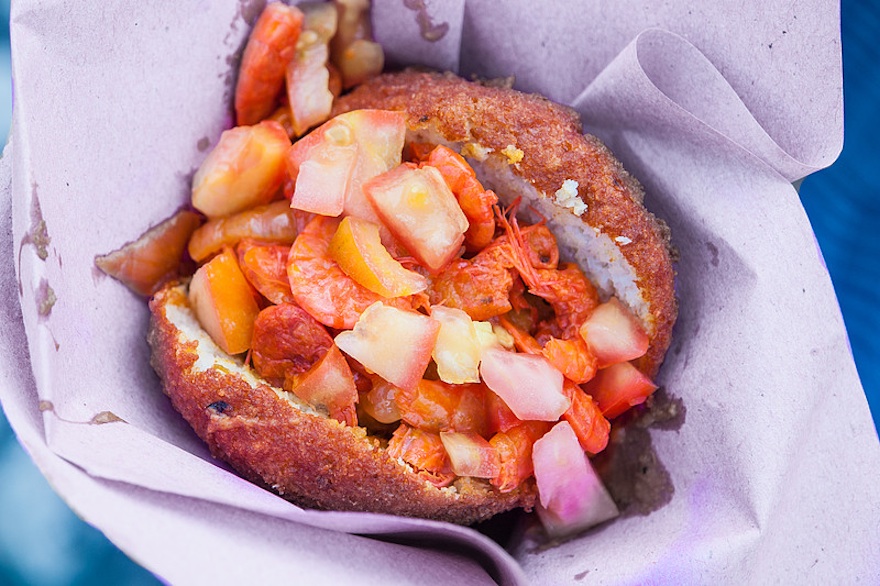Expect greasy fingers, expect to ask for seconds, and expect to be surprised by the comingling of tastes and textures when you sink your teeth into Bahia’s most iconic snack: acarajé. While it can be found in Rio de Janeiro, acarajé is not prolific in Brazil. To appreciate this fritter, travel to Salvador de Bahia, Brazil’s center of Afro-Brazilian culture.
Salvador de Bahia, in northeast Brazil, is a UNESCO World Heritage Site that is especially popular with visitors for its old, colonial, and largely restored center with cobbled streets, called Pelourinho.
Here, amidst brightly painted houses, you’ll find Baianas de acarajé, women in billowing skirts and pieces of cloth wrapped tightly around their heads, selling the city’s most quintessential snack: acarajé. In fact, this snack is so important to the Bahia region that in 2005 Brazil recognized the Oficio de Baianas de acarajé (the occupation of the acarajé vendors) as an Immaterial Patrimony of Brazilian Culture. [pagebreak]
Acarajé was first sold on the streets of Bahia by freed female slaves in elaborate dresses that until the 20th century, were a common sight in this region. The multi-layered dresses are traditionally white, although today’s versions include an array of bright colors. They consist of a petticoat (anáguas), a five-meter long piece of cloth wrapped around the waist to form a billowing skirt (saia), and a bodice composed of lace or embellished with embroidery, all of which is covered with lots of jewelry.
When slavery was abolished and sugar plantations collapsed, acarajére remained. It was and is still an important part of Candomblé, a syncretic and pluralistic Afro-Brazilian religious tradition. (It’s not widely practiced in Brazil but its practice is common in the state of Bahia.) Acarajé is one of the foods that are offered during Candomblé ceremonies. [pagebreak]
So, what is an acarajé?
The basic ingredients are black-eyed beans, onions, and shrimp, all of which are mashed and mixed. These balls of dough are fried in dendê, palm oil. Afterwards, the vendor will halve the acarajé and cover both halves with spicy pastes called vatapá (made with manioc flower, dried prawns, and coconut milk) and caruru (made with okra, onions and cashew nuts). If you don’t like spicy food, ask the vendor to omit the pastes. The snack is topped off with a salad and additional shrimp. The patty is crunchy on the outside and soft on the inside and is best eaten piping hot.
Where do you eat acarajé
You won’t have any problems finding this snack. It’s sold throughout the day in the street, in plazas, and along the coast at tabuleiros de acarajé, as the foodstalls are called. They can be found in pretty much every neighborhood.
The “best place” depends on the local you ask. I like Casa da Dinho do Acarajé at Largo de Santana in the Rio Vermelho district. Tel: (71) 3334-1703, open daily 8-11:30pm / Fri-Sun noon-3:30 pm. You may soon find your own favorite.


![Making Mealtime Matter with La Familia: Easy Sofrito [Video]](https://thelatinkitchen.com/wp-content/uploads/2015/10/sofrito-shutterstock__0-500x383.jpg)
![Easy Latin Smoothies: Goji Berry Smoothie [Video]](https://thelatinkitchen.com/wp-content/uploads/2015/12/goji_berry-shutterstock_-500x383.jpg)
















![Fun and Fast Recipes: Fiesta Cabbage Salad [Video]](https://thelatinkitchen.com/wp-content/uploads/2015/11/fiesta_cabbage_slaw-shutterstock_-500x383.jpg)









